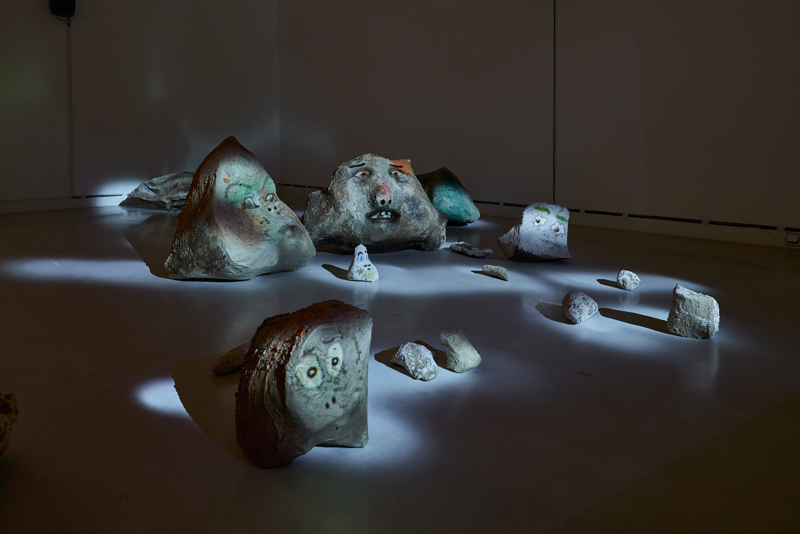
On the Shoulders of Giants
26/02/16—22/05/16
Cao Dan
Cao Fei
Ragnar Kjartansson
Agnieszka Kurant
Zac Langdon-Pole
Goshka Macuga
Kris Martin
Deimantas Narkevicius
Egill Sæbjörnsson
“Bernard of Chartres used to compare us to dwarfs perched on the shoulders of giants. He pointed out that we see more and farther than our predecessors, not because we have keener vision or greater height, but because we are lifted up and borne aloft on their gigantic stature.”
(John of Salisbury: Metalogicon 3,4,46–50)
This metaphor was first written down in 1159, and was referring to the literary and philosophical knowledge of antiquity. Its relevance can be demonstrated by tracing its history down the centuries, with new additions here or adaptations there, through to the present day. Isaac Newton famously explained, “If I have seen further, it is by standing on the shoulders of giants.” Until recently the British two-pound coin featured the phrase “Standing on the shoulders of giants” around its edge, and the Oasis album which heralded a new style and a new line-up for the band bore (almost) the same title. The saying is as contemporary now as it was a century ago, because nothing comes from itself, there was always a Before. What connects every person on earth is the fact that we all have a history. Rather than existing in isolation, in a single moment, we are all bound together in an interwoven network of biological, social, professional, ideological and genetic relationships. In countless spheres of life we follow those who have gone before us: our forerunners. In families there are ancestors, with respect to history or career there are generally predecessors, researchers and scholars rely on the findings of pioneers, while thought and imagination are sparked by the achievements of founders, inventors, groundbreakers, and modernisers. The history of humankind is made up of an accumulating wealth of events, discoveries, and triumphs which provide a secure footing for subsequent generations.
The international group-exhibition On the Shoulders of Giants is devoted to the theme of predecessors in contemporary art. This involves patterns of evolutionary phases or family relationships as much as it addresses the relationship of contemporary artists to the works and achievements of their counterparts from the past. Being successors of specific human beings, artistic achievements or stylistic schools the artists’ oeuvre is trapped in the ongoing quest of being evaluated and classified. The urge to create something new which has never been seen or thought before grows together with the fear to create something strange-looking, not being easily grasped or categorised. This tension characterises artistic creativity: what am I building upon? Where are my roots? What am I taking over? What am I doing without? How can I modernise? What can I get from myself?
Feeling like a dwarf on the shoulders of giants is an everyday sensation, for their size when measured in comparison mostly seems unattainable. Yet the dwarf has one major advantage over the colossal, bulky giant: his small, light stature means he can climb up onto the giant and thus benefit from him. In this manner, he can exploit the pioneering achievements of his predecessors, in the fullness of time, towering over the giant as he looks out onto virgin territory. But working one’s way up to the level of previous findings, experiences, and the existing treasure-trove of knowledge is a gruelling and challenging undertaking. The shoulders of giants first have to be climbed!
The exhibition On the Shoulders of Giants is by no means an exhortation to put up with what has already been achieved. On the contrary, blind, dogmatic assumptions can only be avoided by constantly questioning the ruling consensus. Exploring the roots and influences of visual artists, it attempts to recognise the successes of predecessors by both critically considering them and actively using them – for something altogether new.
Curated by Stefanie Böttcher.


Installation view: Egill Sæbjörnsson: The Egg or the Hen, Us or Them, 2011 (Detail)

Installation view: Kris Martin: Mars, 2012; Goshka Macuga: Aby Warburg, 2014; Agnieszka Kurant: Phantom Estate, 2013

Installation view: Agnieszka Kurant: Phantom Estate, 2013; Goshka Macuga: Backdrop. Living room, 2014

Installation view: Ragnar Kjartansson: Me and My Mother 2000, 2000; Me and My Mother 2005, 2005; Me and My Mother 2010, 2010; Me and My Mother 2015, 2015

Installation view: Cao Fei: Father, 2005; Cao Dan: My Father's Journey, 2008

Installation view: Deimantas Narkevičius: Ausgeträumt, 2010

Installation view: Matthew Buckingham: Caterina van Hemessen is Twenty Years Old, 2009

Installation view: Zac Langdon-Pole: end of history, 2015; The watchman and the spy, 2015; Transit of Mercury November 9th 1769, 2015; motherland, 2015; Implements Rained Down on the Earth from the Clouds, 2015
